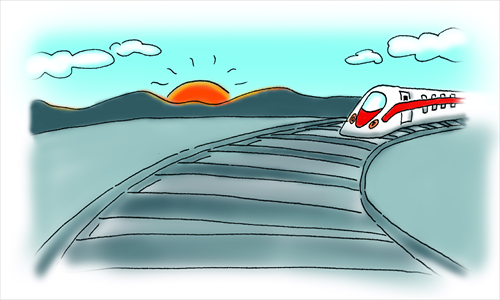Beijing’s long-term vision poses challenge to EU’s narrowness

Illustration: Liu Rui/GT
Beset by a refugee crisis originating from the civil war in Syria as well as the unresolved problems of the Greek economy, it is obviously hard these days for Europeans to prioritize their relations with China.
Nevertheless, given China's growing global influence and the apparent turmoil within the EU concerning collective cooperation and long-term strategy, it would be wise for Europe to remember to pay attention to its interactions with its second biggest trading partner, even if these seem less important than other issues at present.
While Europeans bicker about how to solve the problem of migrants and let Greece fester in the southeastern corner of the continent, China is quietly pursuing infrastructure development and improvements to transport networks that the EU has long neglected.
The Chinese "One Belt, One Road" (OBOR) project represents a clear vision of connectivity across the Eurasian landmass and beyond, the likes of which Europe has not troubled to formulate. Even if parts of OBOR prove difficult to implement successfully, the mere fact that Beijing has a long-term strategy for the improvement of trade channels where Europe does not is in itself significant.
In Greece, where finding a solution to a national insolvency has proved beyond the ken of the combined governments of the European continent, the Chinese shipping company COSCO has brought prosperity to the previously moribund container terminal at Piraeus.
Since COSCO obtained a 35-year lease in 2009, container traffic at the facility has increased at least fivefold, reaching 6,000 containers per day. Costs have been reduced, placing Piraeus among the top 10 ports in Europe. The electronics giant Hewlett-Packard has been sufficiently impressed to strike a deal with COSCO and Greek railways to establish a hub for its goods at Piraeus. COSCO is now among the bidders to buy a 51 percent stake in the container port.
Piraeus in fact represents not only the endpoint of the maritime Silk Road section of OBOR, which connects Shanghai with Greece via the Straits of Malacca, the Indian Ocean and the Suez Canal, but also the triumph of Chinese vision and versatility in the context of the vacuum left by a lack of unified EU policy regarding the need for improved infrastructure in its own backyard.
Another issue is Central and Eastern Europe's aging railway networks. A trip through Serbia a few years ago brought home to me how badly in need of renewal these are. Near the border with Hungary, an unknown wit had inscribed on a crumbling wall the words, "Need more speed." According to a GPS reading, when our train reached this point it had taken 12 hours to cover the 100 kilometers (as the crow flies) from Belgrade. Thus China's proposal to build a high-speed railway from Belgrade to Budapest, which will cut journey time to three hours, appears a very logical step.
Beijing is also negotiating with Macedonia and Greece to extend the Budapest to Belgrade rail link all the way down to Piraeus. COSCO's containers will therefore eventually be able to speed their way to Central Europe even faster than before, a positive outcome for all sides.
China's involvement in renewing the railways of Southeastern Europe also, however, begs several questions: why hasn't the EU set to work on this issue? Why is China able to get much-needed improvements done in a faraway land when the EU appears unable to achieve anything which demonstrates similar ambition and breadth of vision on its own doorstep?
China now has a strategic partnership with Serbia, and has already constructed a 1,500-meter-long "Friendship Bridge" across the Danube in Belgrade. It also has a similar strategic partnership with Poland, which was visited early this month by a group of vessels from the People's Liberation Army Navy.
Even the Czech Republic, which formerly had rather cold relations with China on a political level, is now, under President Milos Zeman, attempting to establish much warmer ties.
China has also initiated a forum at which to meet with Central and Eastern European leaders called "16+1," at which it has made promises of investment in Central and Eastern Europe.
Recent disagreements over refugee quotas revealed a surprising and unpleasant split in the EU.
Several governments in Central and Eastern Europe (the Czech Republic, Hungary, Slovakia and Romania) voted against receiving a quota of refugees. At one point in the crisis, the Czechs even went so far as to claim that the Schengen agreement on free movement of people across borders had broken down.
Cracks have therefore begun to appear in the fragile façade of the European Union at the same time that China is establishing a presence in Central, Eastern and Southern Europe.
While some might suggest that China is exploiting those cracks to develop its own interests, the reality is that it is Western Europe's inability to fully integrate Central and Eastern Europe into the EU that has left a vacuum that needed filling, for the benefit of all concerned.
The author is Lecturer in International Relations, Jan Masaryk Centre for International Studies, University of Economics in Prague. opinion@globaltimes.com.cn